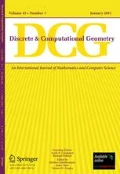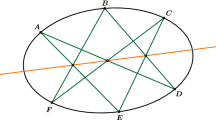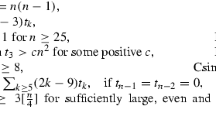Abstract
Given a sextuple of distinct points A, B, C, D, E, F on a conic, arranged into an array \(\big [ \begin{array}{ccc} A &{} B &{} C\\ F &{} E &{} D \end{array} \big ],\) Pascal’s theorem says that the points \(AE \cap BF, BD \cap CE, AD \cap CF\) are collinear. The line containing them is called the Pascal of the array, and one gets altogether 60 such lines by permuting the points. In this paper we prove that the initial sextuple can be explicitly reconstructed from four specifically chosen Pascals. The reconstruction formulae are encoded by some transvectant identities which are proved using the graphical calculus for binary forms.




Similar content being viewed by others
Notes
If one tries to draw a diagram of the sextuple together with all 60 of its Pascals, a dense and incomprehensible profusion of ink is the usual outcome. The curious reader is referred to http://mathworld.wolfram.com/PascalLines.html.
The conic itself is fixed throughout, and as such assumed to be known.
References
Abdesselam, A.: On the volume conjecture for classical spin networks. J. Knot Theory Ramif. 21(3), 1250022 (2012)
Abdesselam, A., Chipalkatti, J.: Brill–Gordan loci, transvectants and an analogue of the Foulkes conjecture. Adv. Math. 208(2), 491–520 (2007)
Baker, H.F.: Principles of Geometry, vol. II. Cambridge University Press, Cambridge (1930)
Blinn, J.F.: Lines in space, part 8: line(s) through four lines. IEEE Comput. Graph. Appl. 24(5), 100–106 (2004)
Castravet, A.-M., Tevelev, J.: Hypertrees, projections, and moduli of stable rational curves. J. Reine Angew. Math. 675, 121–180 (2013)
Chipalkatti, J.: On the coincidences of Pascal lines. Forum Geom. 16, 1–21 (2016)
Clebsch, A.: Theorie der Binären Algebraischen Formen. B.G. Teubner, Leipzig (1872)
Conway, J., Ryba, A.: The Pascal mysticum demystified. Math. Intell. 34(3), 4–8 (2012)
Cvitanović, P.: Group Theory. Birdtracks, Lie’s, and Exceptional Groups. Princeton University Press, Princeton (2008)
Dolotin, V., Morozov, A.: Introduction to Non-linear Algebra. World Scientific, Hackensack (2007)
Grace, J.H., Young, A.: The Algebra of Invariants. Chelsea, New York (1962)
Harris, J.: Galois groups of enumerative problems. Duke Math. J. 46(4), 685–724 (1979)
Howard, B., Millson, J., Snowden, A., Vakil, R.: The equations for the moduli space of \(n\) points on the line. Duke Math. J. 146(2), 175–226 (2009)
Joubert, P.: Sur l’équation du sixième degré. C. R. Acad. Sci. Paris 64, 1025–1029 (1867)
Kadison, L., Kromann, M.T.: Projective Geometry and Modern Algebra. Birkhäuser, Boston (1996)
Kraft, H.: A result of Hermite and equations of degree 5 and 6. J. Algebra 297(1), 234–253 (2006)
Kung, J.P.S., Rota, G.-C.: The invariant theory of binary forms. Bull. Am. Math. Soc. (N.S.) 10(1), 27–85 (1984)
Lafforgue, V.: Chtoucas pour les groupes réductifs et paramétrisation de Langlands globale (2012). arXiv:1209.5352
Olver, P.J.: Classical Invariant Theory. London Mathematical Society Student Texts, vol. 44. Cambridge University Press, Cambridge (1999)
Pedoe, D.: How many Pascal lines has a sixpoint? Math. Gaz. 25(264), 110–111 (1941)
Pedoe, D.: Geometry: A Comprehensive Course. Dover Books on Advanced Mathematics, 2nd edn. Dover, New York (1988)
Richter-Gebert, J., Lebmeir, P.: Diagrams, tensors and geometric reasoning. Discrete Comput. Geom. 42(2), 305–334 (2009)
Salmon, G.: A Treatise on Conic Sections, 6th edn. Chelsea, New York (2005)
Schreck, P., Mathis, P., Marinković, V., Janičić, P.: Wernick’s list: a final update. Forum Geom. 16, 69–80 (2016)
Seidenberg, A.: Lectures in Projective Geometry. Van Nostrand, New York (1962)
Wernick, W.: Triangle constructions with three located points. Math. Mag. 55(4), 227–230 (1982)
Author information
Authors and Affiliations
Corresponding author
Additional information
Editor in Charge: János Pach
Rights and permissions
About this article
Cite this article
Abdesselam, A., Chipalkatti, J. On the Reconstruction Problem for Pascal Lines. Discrete Comput Geom 60, 381–405 (2018). https://doi.org/10.1007/s00454-018-9981-4
Received:
Revised:
Accepted:
Published:
Issue Date:
DOI: https://doi.org/10.1007/s00454-018-9981-4




